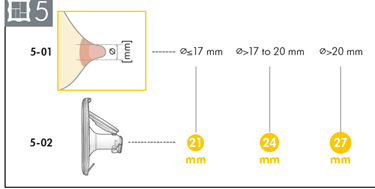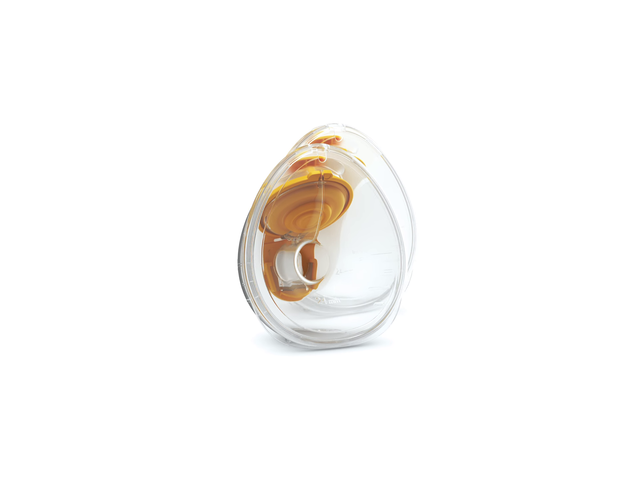How do the wearable milk collection cups work?
The Hands-free Collection Cups provide users the possibility of hands-free pumping while maintaining Medela’s valued performance.
Vacuum is applied to the breast by means of a tubing connection to the pump. The air flow between the pump and the hands-free cups generates a vacuum that is applied to the breast for milk expression. The milk is then collected within the cup and can be poured from the cup into a bottle or storage bag at the end of the pumping session. The Hands-free Collection Cups are not intended to be used for milk storage.
How much milk do the wearable breast pump cups hold?
Each Hands-free Collection Cup can hold up to 150ml / 5oz breast milk.
How do the breast pump collection cups hold or keep the milk inside safely?
The Hands-free Collection Cups create a seal with the membrane which sits between the breast shield and cup (shell) to prevent milk leakage while in use.
How do the wearable cups hold on to the breast?
The Hands-free Collection Cups are placed on the breast inside the mum’s bra. The fit of the bra and vacuum generated from the pump creates a seal that allows the cups to stay in place while pumping and collecting milk.
Are the milk collection cups compatible with pumps from other brands or just with Medela pumps?
The Hands-free Collection Cups are not compatible with pumps from other brands and only compatible with Medela double electric breast pumps, specifically FreestyleTM and Swing MaxiTM .
Can I keep using my current Medela double electric personal use pump with the Hands-free Collection Cups?
Yes, absolutely. The Hands-free Collection Cups are compatible with the Medela double electric personal use breast pumps specifically FreestyleTM and Swing MaxiTM even if they were previously bought in a classic configuration (with bottles).
Is double pumping more effective?
Double pumping both breasts together compared to single pumping (one breast at a time) has been shown to stimulate an additional milk ejection (milk let-down) which on average results in 18% more milk pumped over a 15 minutes pumping duration.6 It also means that the milk has a higher fat and calorie content and there is better breast drainage.4
How can I connect the Hands-free Collection Cups to my breast pump?
The Hands-free Collection Cups are connected to the breast pump by way of a tubing connection. The breast milk collection cups are provided with one integrated tubing that you can simply connect to your existing system.
- Connect the long end of the tubing to your Medela personal use pump.
- The tubing can be connected facing inwards (towards the breasts) or outwards (towards the arms) based on personal preference. Ensure that the tubing is not pinched or bent during use.
- For Instructions for Use on how to single or double pumping, refer to your Medela compatible personal use pump Instructions for Use.
Do wearable breast pump cups work as well as pumping with the classic bottle pumping kit?
The Hands-free Collection Cups offer pumping mums the same valued Medela performance allowing mums the freedom to choose which pumping kit is right for them.
How long do you have to pump with wearable cups?
Pumping duration is dependent on each user. With the Hands-free Collection Cups users can expect to pump for about the same duration as with the classic PersonalFit Flex™.
Are wearable breast pump collection cups hospital grade?
These cups are not for use by multiple users as with hospital grade equipment. Pump kit parts which are used by multiple mums must be autoclaved/ sterilised as per specific hospital guidelines. These cups are designed for personal use which can be safely washed daily and sanitised as per normal personal pump kit sanitizing and washing guidelines.
The Hands-free Collection Cups are only compatible with the Medela personal use pumps, specifically FreestyleTM and Swing MaxiTM.
Are the wearable milk collection cups adaptable to different breast shapes?
The Hands-free Collection Cups are designed in an anatomical shape to comfortably fit to most breasts. The Hands-free Collection Cups come in three tunnel sizes; 21mm, 24mm and 27mm to maximize comfort and effective milk drainage during pumping. To ensure proper fit with the milk collection cups, check out our Medela Breast Shield sizing guide https://www.medela.com/fittingguide.
Can I exclusively pump with wearable breast pump cups?
Medela recommends choosing the Symphony rental pump to build supply in pump dependent mums. However, once a mother’s milk supply is established (usually around 4 weeks), Medela’s whole range of personal use double electric pumps are designed for users who need to pump a lot.
How do I select the correct breast shield size?
Select the breast shield size by measuring the diameter of your nipple. It is best to select the breast shield size that is slightly larger than your nipple.
The 21mm size is for smaller or up to 17mm nipple diameter. The 24mm size is for larger than 17mm up to 20mm nipple diameter.
The 27mm size is for larger than 20mm nipple diameter.

Here’s how to check:
- Using the 24 mm sized shields included with your pump (or the size chosen after measuring your nipples), center your nipple and gently hold the Hands-free Collection Cup against your breast. (Please note: pressing any pumping shields too hard against your breasts when pumping could restrict the flow of milk through the ducts).
- To pump at your maximum comfort vacuum, which is the highest level you can tolerate comfortably, increase the vacuum gradually until it feels slightly uncomfortable (not painful), then turn it down one notch.
- When your breast shield fits correctly, your nipple will be centered in the breast shield tunnel and will move freely during pumping.
- Visit www.medela.com/fittingguide, or if you are still unsure that you selected the correct size, see a lactation consultant or breastfeeding specialist.
How to know you are using the pump and hands free collection cups for the recommended time?
Many mums don’t sense their let down, so watch for this as you pump. When you start to see jets of breast milk squirting into the collection cup, you’ll know it’s happening.5
As you are using a breast pump with 2-Phase Expression™ technology, it will have a stimulation mode and an expression mode. The stimulation mode normally lasts about one minute (Note: For Freestyle Hands-free it normally lasts two minutes), but once you see milk flowing as described, it’s important to switch to the expression phase. This is because that first let down typically provides around 36% of the milk volume, so you’ll be taking advantage of your flow to collect more milk.5,6
During the expression phase, pump at your maximum comfort vacuum, which is the highest breast pump setting you can use while remaining comfortable. In research, this was found to remove a similar amount of milk as a baby does during breastfeeding.7, 8
To find the right level for you, increase the breast pump suction gradually until it becomes slightly uncomfortable, and then turn it down a notch. Pumping breast milk shouldn’t hurt. If you feel discomfort while expressing, try reducing the breast pump suction.
Once your supply is established (after about four weeks), you can start tailoring how many minutes you need to pump for, which can save you valuable time. Some mums need to pump longer than others due to their number of let downs, which determine how often and how long milk flows.9, 10 What’s really amazing is that while every mum has a unique flow pattern, yours will be the same each time you pump as well as when you breastfeed.11
It is important to note that it could be potentially easier for a user to forget how long they have been using in-bra collection cups when multi-tasking. It is advised to not overstimulate the breasts and prolong use of the breast pump collection cups unnecessarily.
Do wearable breast pump cups cause more soreness?
As with all breast shields, they come in to contact with the breast and nipple area, therefore it is important to have the right fit to prevent any soreness. The right size of breast shield (the funnel-shaped part that fits over your breast) is an essential part of optimal milk flow during pumping as well as to help obtain maximum comfort.
The breast shield tunnel should surround your nipple closely but leave enough space for it to move back and forth freely without rubbing. It shouldn’t chafe or pull too much of your areola (the darker area around the nipple), or the breast skin around it, into the tunnel as you pump. A badly fitting breast shield can reduce the amount of milk you express, which is why Medela makes breast shields in several different sizes.
The tunnel diameter on the Hands-free Collection Cups is sized the same as the MedelaPersonalFit Flex™ breast shields from all the pumps in the range. Therefore, with correct sizing and use of the Hands-free Collection Cups it should support a comfortable pumping experience.
Medela offers a breast shield sizing guide which applies to PersonalFit Flex™ breast shields and the Hands-free Collection Cups www.medela.com/fittingguide.
Seek advice and support from your lactation consultant / breastfeeding specialist if you experience discomfort or soreness when pumping.
How many breast shield sizes are available?
There are 21mm and 24mm breast shield sizes included in the pack. An additional 27mm size is available to purchase when required.
Do you have to be sitting or can you be more active?
The Hands-free Collection Cups (or wearable breast pump cups) are great for relaxing back and taking a moment, and also for those times when you have to be on-the-go. Whether you choose to pump while sitting, walking around, or tending to your baby, the Hands-free Collection Cups allows you both options. It is good to note as with all pumps, the cups are not designed to be used when leaning over completely or during exercise as there is an opening (pouring spout) at the top of the cups through which milk could spill out.
Do I need a special bra to be able to use the Hands-free Collection Cups?
A special bra is not required when using the Hands-free Collection Cups. The wearable collection cups are designed to fit into most nursing bras.
For the ultimate hands-free experience, check out our: Keep Cool Bra / 3 in 1 nursing bra
When cups are full can you empty them and then keep pumping?
Yes! The Hands-free Collection Cups hold 150ml / 5oz of breast milk each.
When the cups are full:
1. Pause the pumping by pressing the play/pause button on the display.
2. Pour the expressed milk into a breast milk-safe collection bottle or storage bag.
3. Place the Hands-free Collection Cups back in position and continue the pumping session.
At times I produce a lot of milk, can I pause the pump to empty the full cups?
Yes. Medela personal use pumps do not shut off automatically when the milk collection cups are full. However, because of the Hands-free Collection Cups’ transparent design and side scale measurement indicator, it makes it easy to monitor how much has been collected and pause the pumping when the pump cups are full.
Are the Hands-free Collection Cups easy to clean?
With only three parts to clean :
1. Cup
2. Membrane
3. Breast shield
The Hands-free Collection Cups have been designed to make cleaning easy. The cups are dishwasher safe on the top rack only. This excludes the tubing.
How often do I need to clean the Hands-free Collection Cups?
The Hands-free Collection Cups should be boiled before first use, washed after every use (hand wash or dishwash), and sanitised once per day (boil or microsteam). Always allow all parts to completely dry on a clean towel.
How often do they need to be sterilised?
The Hands-free Collection Cups should be boiled before first use, washed after every use (hand wash or dishwash), and sanitised once per day (boil or microsteam). These cups are not for hospital use which are to be sterilised and/or autoclaved.
Are the breast pump cups dishwasher safe?
The Hands-free Collection Cups are dishwasher safe on the top rack only. This excludes the tubing. Do not clean or rinse the inside of the tubing under any circumstances. The exterior of the tubing can be wiped down with a damp cloth if dirty.
How can I clean and dry the tubing?
The Medela personal use breast pump features a closed system so milk cannot get into the tube when used as instructed. Do not clean or rinse the inside of the tubing under any circumstances. The exterior of the tubing can be wiped down with a damp cloth if dirty.
Can I store milk in the wearable collection cups between pump sessions?
No. Do not store expressed breastmilk within the cups. When a mum has finished pumping, any breast milk expressed should be poured into a milk-safe storage container, stored in the refrigerator, freezer or used immediately.
For more information, see https://www.medela.com/breastfeeding/mums-journey/storing-and-thawing-breast-mil
When finished pumping, how can I drain the milk from the tunnel into the cups?
To avoid milk spilling out of the breast shield tunnel, when finished pumping, keep the pump running and slightly lean forward to ensure all milk from the nipple tunnel enters the milk collection cups. Once there is no more milk in the tunnel stop the pump by pressing the start or pause button.
How can I store the Hands-free Collection Cups for long-term?
Before long-term storage, disassemble and sanitise all parts (except for the tubing). Do not store the Hands-free Collection Cups in their assembled state over an extended period of time.
Can I return the Hands-free Collection Cups if I change my mind?
The Hands-free Collection Cups pump set is a single-user product, therefore for hygiene and safety reasons, they can only be used by one person. This means that once the tamper seal is broken, you will not be able to return the product to Medela or a retailer unless it is faulty. If you received a faulty or malfunctioning device, please contact the Medela customer service team to see if you are eligible for a warranty replacement.
How do I dispose of the Hands-free Collection Cups?
The breast shields, outer cups, tubing, and membranes
are made of plastics that are not harmful to the environment when disposed of as household waste. You can recycle or dispose of it according to local regulations.






















































